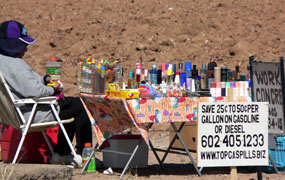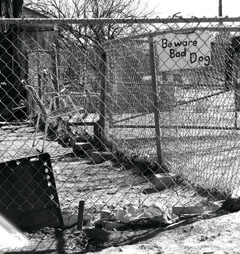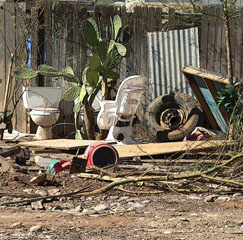|
|
||||
Seeing South Phoenix Thru a New GazeAsh Rupp
I decided to explore South Phoenix without the class. I took my boyfriend with me and we drove down to the areas that I have been studying. I wanted to see if my interpretations about the city would change if my company changed. When everyone in your car is taking an Anthro class, already you have a different view of the world and may see things differently than those who have not been exposed to anthropology. My boyfriend noticed many of the same things I had remarked on during my first visit. He was amazed that he had lived in the valley for five years and had never really spent any time in this area. He was also shocked by some of the homes and the kinds of lives some of the residents must live. I did purposely drive by some of the worst properties, but I also drove him by the new developments. He is in the mortgage industry and is always very interested in property values. He was amazed that the developers were taking such a risk building new homes in this area. He said that that would typically be seen as a poor investment and he wondered how long this new construction could really last.
Chris and I both grew up in similar towns. He grew up in Palmer, Alaska, and I grew up in West Lafayette, IN. They are both small towns and even though his is in Alaska, it has a very Midwest feel to it. We both had poverty in our towns. We both remember there were kids who had to have free lunches at school and kids who couldn’t afford the field trip fees, but the poverty we saw in our towns was dramatically different from the poverty that exists in South Phoenix. According
to the 2000 census data, South Phoenix has one of the highest
percentages of people living below the poverty level in the entire
Phoenix Metro area; 25.8%. One third of South Phoenix residents use
more than 35% of their income to pay for rent or mortgages. This
leaves the rest of the money for food, bills, and other
necessities. To better illustrate the level of poverty in South
Phoenix it is important to look at mortgage and rental prices in the
area. The majority of residents, 60+%, live in housing that costs
them between $300- $750.00. We now live in a resort style apartment “community.” We have totally bought into what designer Wayne Williams, a community planner for gated neighborhoods in the U.S., calls “positive ghetto-ism.” As Williams stated in an article written by Evan McKenzie titled, Privatopia: Homeowner Associations and the Rise of Residential Private Government, this really means that we live in a gated community that sites up against a golf course and is within walking distance to some of the best upscale shopping in the valley. While no explicit effort has been made to discriminate against prospective residents, there are monetary factors that make it impossible for everyone to live here. Chris and I chose this property very carefully. He takes a lot of business trips and I am often alone for four or five days out of the week. We both wanted a place that was safe enough that I would not have to worry when he was gone. This provides that amply. I do notice that this area has little to no ethnic or cultural diversity however. Everything is perfect, manicured, plastic, vanilla, suburbia. While Chris and I enjoy this area for the security purposes, we don’t feel great about segregating ourselves from the rest of the city in order to feel “secure.” I think the title of Ellin Nan’s editorial says it best, she espouses that the gated communities being build are really “architecture of fear.”
|
||||
|
|
||||


 I
told him about the guest speaker we spoke with the previous week,
George Young, a key member of the South Mountain Village Planning
Committee. He spoke to our class about his committee’s vision for a
new South Phoenix. His committee is developing areas of South
Phoenix that they feel are ‘unsightly’ in order to bring people into
the community to live. In one of the brochures he gave us, they
estimate that the population in South Phoenix will grow to 113,513
by the year 2020 (the population in 2000 was 91,907). The area that
they work within is 39.8 square miles, and they hope that with all
of the improvements to housing and the general look of the area that
they can add an extra 10,000 homes by 2020 (South Mountain Village
Planning Dept, 4). Chris was as amazed to hear this as I had been.
While I believe that this committee has good intentions, they do not
seem to be concerned with what the current residents of the South
Phoenix area want. They are even changing the name of the community
from South Phoenix to South Mountain Village.
I
told him about the guest speaker we spoke with the previous week,
George Young, a key member of the South Mountain Village Planning
Committee. He spoke to our class about his committee’s vision for a
new South Phoenix. His committee is developing areas of South
Phoenix that they feel are ‘unsightly’ in order to bring people into
the community to live. In one of the brochures he gave us, they
estimate that the population in South Phoenix will grow to 113,513
by the year 2020 (the population in 2000 was 91,907). The area that
they work within is 39.8 square miles, and they hope that with all
of the improvements to housing and the general look of the area that
they can add an extra 10,000 homes by 2020 (South Mountain Village
Planning Dept, 4). Chris was as amazed to hear this as I had been.
While I believe that this committee has good intentions, they do not
seem to be concerned with what the current residents of the South
Phoenix area want. They are even changing the name of the community
from South Phoenix to South Mountain Village.